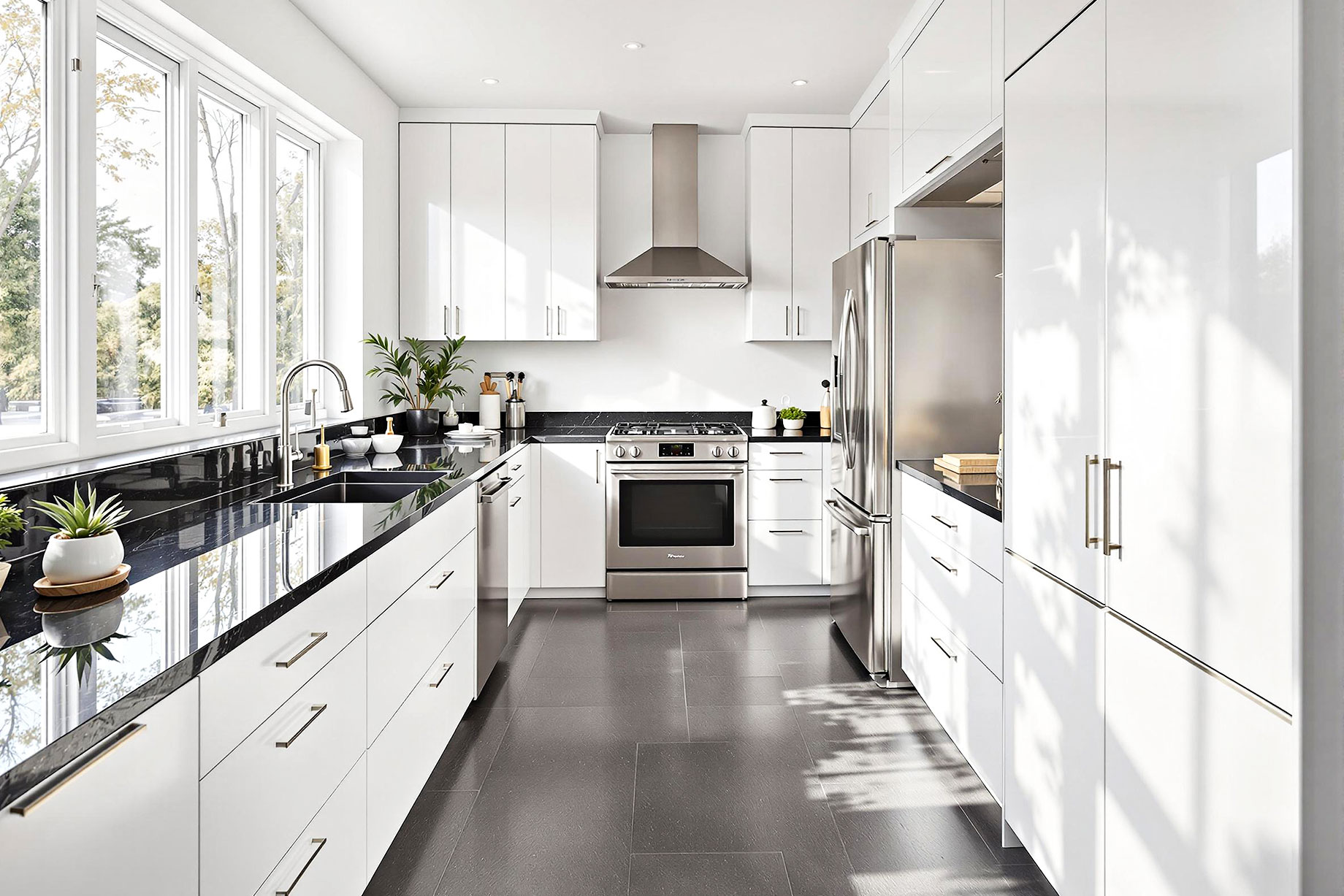
A well-planned budget is essential for any kitchen renovation. Without clear financial guidelines, costs can escalate quickly, leading to unnecessary expenses or unfinished projects. The total cost of a remodel depends on factors like kitchen size, materials, and labor.
Homeowners in the United States typically spend between $14,000 and $40,000 for a kitchen remodel, with higher-end renovations exceeding this range. Smaller kitchens (under 100 square feet) may cost $5,000 to $25,000, while larger kitchens (over 200 square feet) can reach $50,000 or more.
Planning ahead ensures that essential upgrades, such as cabinetry and appliances, fit within financial constraints. A structured budget allows homeowners to prioritize spending, allocate funds for unexpected costs, and maximize long-term value. This guide outlines the key steps to creating a realistic kitchen renovation budget, covering cost breakdowns, savings strategies, and essential planning tips.
Determine Your Total Budget
Setting a clear budget prevents overspending and ensures that a kitchen remodel delivers the best return on investment. Kurt of Kitchen & More recommends allocating 5% to 15% of a home’s value to a kitchen renovation. This range allows for meaningful upgrades without over-investing in a space that may not significantly increase resale value. A $200,000 home typically supports a budget between $10,000 and $30,000, while a $500,000 home allows for a $25,000 to $75,000 remodel.
Breaking down national averages provides a clearer picture of remodeling costs. A midrange minor kitchen remodel averages $27,492, covering cosmetic updates, while a major midrange remodel averages $79,982. This could include custom cabinetry, high-end appliances, new flooring, and layout modifications.
Establishing a spending limit early in the process helps control costs and prevents budget creep from unexpected upgrades. Without a defined range, material and labor choices can easily push expenses beyond initial estimates.
Breakdown of Kitchen Remodel Costs
Breaking down kitchen remodel costs into categories helps with budgeting and prevents overspending in any one area. Cabinets typically take up the largest portion, while appliances, labor, and materials contribute significantly to the overall cost. Allocating funds to each category ensures that essential upgrades fit within the budget while leaving room for unexpected expenses.
- Cabinets (30-40%) – The largest expense in most kitchen remodels. Custom cabinets cost the most, while semi-custom and stock options provide more budget-friendly choices.
- Appliances (20-30%) – High-end models add durability and advanced features, while mid-range or budget-friendly options offer cost savings without sacrificing essential functions.
- Countertops & Flooring (10-20%) – Material choice significantly affects costs. Granite and quartz cost more, while laminate and butcher block provide lower-cost alternatives.
- Labor & Installation (15-25%) – Costs vary based on project complexity and professional rates. Hiring specialists for electrical and plumbing work increases expenses but ensures compliance with building codes.
- Unexpected Costs (5-10%) – Permit fees, structural adjustments, and unforeseen issues should be factored in to prevent budget overruns.
For a $30,000 remodel, cost allocation may look like this:
- Cabinets: $9,000 – $12,000
- Appliances: $6,000 – $9,000
- Countertops & Flooring: $3,000 – $6,000
- Labor & Installation: $4,500 – $7,500
- Unexpected Costs: $1,500 – $3,000
How to Prioritize Your Kitchen Remodel Budget
Balancing essential upgrades with aesthetic improvements keeps a remodel budget under control. Functional changes should take priority over decorative features to ensure the kitchen remains efficient and durable.
1. Separate Needs from Wants
- Needs: Cabinets, countertops, flooring, plumbing, and electrical work.
- Wants: High-end finishes, smart appliances, decorative lighting, custom backsplashes.
2. Make Cost-Smart Choices
Full replacements cost significantly more than refinishing or refacing. Instead of installing new cabinets, applying fresh paint and updating hardware creates a modern look for a fraction of the cost. Laminate countertops mimic stone surfaces at a lower price. Mid-range appliances offer strong performance without the markup of high-end brands.
3. Leave Room for Unexpected Costs
Hidden issues arise once demolition begins, especially in older kitchens. Outdated wiring, plumbing leaks, or structural concerns require immediate attention. Reserving 5-10% of the budget for these expenses ensures the project stays on track without cutting essential upgrades.
Budget-Friendly Kitchen Remodel Tips
Smart material choices, DIY upgrades, and minor layout adjustments help stretch a remodel budget without compromising functionality.
- Work with the Existing Layout: Moving plumbing, gas lines, or electrical wiring increases labor costs. Keeping appliances, sinks, and major fixtures in their current locations eliminates the need for costly rerouting. If extra counter space is needed, consider adding a small island instead of changing the floor plan.
- Refinish Instead of Replace: Painting cabinets, updating hardware, or applying a veneer overlay costs significantly less than installing new cabinetry. Refinishing floors, rather than replacing them, also reduces material and labor expenses.
- Choose Cost-Effective Materials: Laminate countertops cost a fraction of granite or quartz but offer a similar aesthetic. Prefabricated backsplash panels install easily and eliminate the need for custom tile work. Open shelving replaces upper cabinets at a lower price while adding storage and accessibility.
- Take on DIY Projects Where Feasible: Installing light fixtures, painting walls, and swapping out faucets require minimal tools and experience. Tackling these tasks without professional help reduces labor expenses while maintaining control over design choices.
Make Your Kitchen Remodel Pay Off
Kitchen remodels often provide a strong return on investment. Recent data indicates that minor kitchen remodels can recoup approximately 96% of their cost, whereas major upscale remodels yield around a 50% return on investment (ROI).
A structured budget keeps a kitchen remodel financially manageable while allowing for meaningful upgrades. Cost breakdowns help prevent overspending and ensure funds go toward the most impactful changes. A budget worksheet or consultation serves as a useful starting point for defining financial goals and mapping out a cost-effective renovation plan.